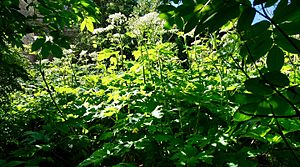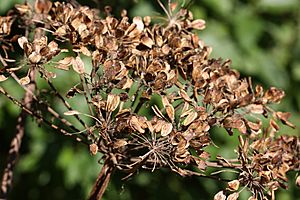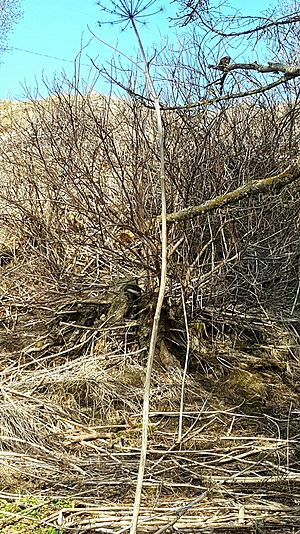Cow parsnip facts for kids
Quick facts for kids Cow parsnip |
|
|---|---|
 |
|
| Cow parsnip | |
| Scientific classification | |
| Synonyms | |
|
See text. |
Cow parsnip (scientific name: Heracleum maximum) is a tall plant. It is the only type of Heracleum plant that naturally grows in North America. People also call it American cow-parsnip, Indian celery, Indian rhubarb, or pushki. Sometimes, it is also known as Heracleum lanatum. The name Heracleum comes from Heracles, a Greek hero, because these plants can grow very large.
Contents
What Does It Look Like?
Cow parsnip is a large herbaceous plant. This means it has soft stems, not woody ones like trees. It can grow taller than 2 meters (6.6 feet). Its stems are hollow and covered with many hairs.
The leaves are very big, sometimes up to 40 centimeters (16 inches) wide. They are split into different sections. Cow parsnip has flower clusters called umbels. These look like upside-down umbrellas. They are typical of the carrot family (Apiaceae). The umbels are about 20 centimeters (7.9 inches) across. They are flat or rounded and made of many small white flowers.
Cow parsnip is often confused with Heracleum mantegazzianum, also known as giant hogweed. Giant hogweed is much bigger. It usually has purple spots on its stems. Its leaves also have sharper edges.
Plant Names
The scientific names for plants can sometimes be tricky. Heracleum maximum and Heracleum lanatum are both names for this plant. Different plant experts might use one name or the other. This is because scientists sometimes have different ideas about how to group plants.
Where Does It Grow?

This plant is native to North America. You can find it in most parts of the United States. It grows from the Aleutian Islands and Alaska in the northwest. It reaches all the way to Newfoundland on the east coast. It also grows south into California, New Mexico, Kansas, Ohio, and Georgia.
Cow parsnip can grow from sea level up to about 2,700 meters (9,000 feet) high. It is very common in Alaska. There, it often grows near plants like devil's club. In Canada, it grows in every province and territory except Nunavut. In some states, like Kentucky and Tennessee, it is considered rare or a "Special Concern" plant. You can also find this plant in Siberia, East Asia, and the Kuril Islands.
How People Use It
Cow parsnip is a good food source for animals. Cows, sheep, and goats eat it. Many wild animals also eat it, especially grizzly and black bears.
The thick flower stems can be eaten when they are young. You need to peel them first and cook them. Be careful, though, because its flowers look like those of the very poisonous water hemlock.
Indigenous North American people have used cow parsnip for a long time. In spring, they would travel long distances, sometimes over 80 kilometers (50 miles), to find the young shoots. They would peel the young stems and leafstalks and often eat them raw. Early American settlers would cook the plant. The peeled stalks taste and feel like celery. This is why it was sometimes called "Indian celery."
At least seven native groups used the plant for skin problems. They would make a poultice (a soft, moist mass) from it. This poultice was put on bruises or sores. A poultice from the roots was used for swollen feet. Dried stems were used as drinking straws for older or sick people. Children sometimes made flutes from the hollow stems. You can also rub a liquid made from the flowers on your body to keep flies and mosquitoes away. The roots can even be used to make a yellow dye.
Is It Harmful?
Cow parsnip contains natural chemicals called furanocoumarins. These chemicals can cause a skin reaction. If the clear sap from the plant gets on your skin, it can cause a rash. This rash might look like a burn or blisters. This reaction happens only after your skin touches the sap and then is exposed to sunlight (ultraviolet light). This is called phytophotodermatitis. The marks or scars from these blisters can sometimes last for months or even years. So, it's best to be careful when touching this plant.
Images for kids
See also
 In Spanish: Heracleum para niños
In Spanish: Heracleum para niños




